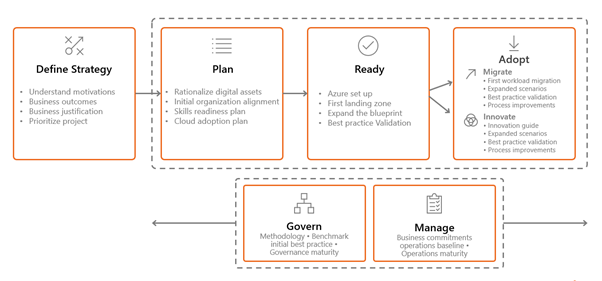Given that many of us have had more than a year of home working, it won’t surprise you to hear that Cloud adoption has surged dramatically over the last 12 months. Indeed, Microsoft Azure has seen a global growth rate of 50%, with demand for products such as Microsoft Teams and Windows Virtual Desktop leading the way[1].
However, this isn’t a blog evangelising the benefits of Microsoft Cloud solutions or remote working. This is a blog about joining the metaphorical dots – properly.
As Microsoft Gold Partners and Azure experts, Transparity have seen a number of new and existing customers who have reaped the benefits of a Cloud-first approach, and want to continue to leverage everything the Microsoft Cloud has to offer. But in order to achieve success, it’s important to define and plan your strategy for adoption.
That’s where Microsoft’s Cloud Adoption Framework comes in.
What is the Cloud Adoption Framework?
Put simply, the Framework provides best practice methodology and advice into Microsoft Azure adoption, collated by Microsoft, its partners and customers. It takes companies through different stages to ensure that they are thinking about the relevant areas and documenting their decisions. This helps them fully prepare before embarking on Cloud adoption and moving resources to the Microsoft Cloud.
It’s not limited to new Cloud customers though; if you have undertaken an Azure migration previously and want to identify if there are any gaps, the Framework is ideal for this. However, we don’t recommend a remediation approach if it can be avoided, as it can take a lot of time and resource to put right.
The below diagram shows the Cloud Adoption Framework:

Why is it important to use the Cloud Adoption Framework?
There’s still a reasonably widespread lack of awareness into why planning your Cloud adoption journey is essential. And that’s OK; not all companies are Azure experts, and we don’t expect them to be! But If you don’t follow Cloud Adoption Framework guidance around areas such as Governance, Costing, Identity and Resource Organisation early, it becomes extremely difficult to remediate at a later date.
As an Azure Partner and member of the Azure Migration Partner programme, at Transparity we use the Framework to steer our customers in the right direction. For instance, many don’t realise that organisational alignment is the most important aspect of any Cloud adoption plan, as these are people who will make the plan a reality. No plan is complete until you understand its people-related aspects.
Additionally, I would say that at around 90% of customers miss out the Strategy, Plan and Ready stage. It’s understandable; they want to get to the migration stage as quickly as possible. But if a customer doesn’t list all of their desired outcomes during the Strategy phase, it’s impossible to know what a successful project looks like.
Putting the work in now will reduce management overhead going forward, freeing up IT teams to focus on delivering value to their staff and customers instead of continually patching or “putting out fires”. For example, creating Azure Landing Zones ensures that governance, security, monitoring and access is implemented before any workloads are migrated, negating the need to remediate afterwards.
As a minimum, you should be thinking about creating internal Cloud Adoption and Cloud Governance teams to assist with your Cloud adoption. We often work with our customers to help identify these stakeholders as part of our Azure Consultancy work, helping align them to the Cloud Adoption Framework.
The Cloud Adoption Framework in action
Transparity have worked with customers of all sizes and in a variety of industries on their digital transformation projects using the Microsoft Cloud Adoption Framework. One customer we worked closely with to improve their systems is a leading home repairs and improvements provider.
Already with over 1000 services contained in Azure, working through the Framework in partnership with them would be a big task. However, the process highlighted areas where best practice could be improved so the company could get the most out of their environment and increase adoption.
Firstly, we worked with them to create a set of Azure Policies to ensure that all workloads met best practice going forward. We then created a new Operating Model and RACI matrix, conveying to internal support teams which engineer or staff member was responsible for different parts of the environment. This ensured that their teams knew where to turn if needed, as well as acting as a checklist to certify that every aspect was being supported.
Finally, Transparity wanted to help the company with a Cost Governance process, ensuring they had clear oversights of cost consumption in each business unit. We worked with them to tag workloads, create cost analysis reports for each business area (Cost Code), and created an internal process using flow charts. This mean that their finance team knew what to do and which stakeholders to engage with if they found their costs increasing.
While the company’s initial Cloud migration had been a success, this example shows why it’s important to use the Framework initially. All of this could have been achieved before migration took place, which would have saved the company time and money.
Next steps
As Microsoft Cloud experts, we offer a complimentary consultation for organisations who want to join the digital dots and take the next step in their Cloud adoption journey. Simply click below to submit your details and one of our Azure experts will be in touch.
[1] https://techhq.com/2021/02/cloud-computing-spend-increased-by-a-third-in-2020/



